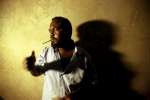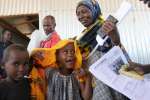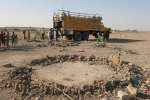- Text size
 |
|  |
|  |
| 
- Français
UNHCR boosts aid delivery inside Somalia
News Stories, 19 July 2011
GENEVA, July 19 (UNHCR) – The UN refugee agency is increasing the delivery of emergency aid in Somalia's south and west while tracking the movement of people into neighbouring countries in order to improve assistance.
Working with local partners, UNHCR has distributed aid packages to some 90,000 people in Mogadishu and Belet Hawa and Dobley in south-west Somalia. These packages consist of plastic sheets, blankets, kitchen sets and jerry cans, among other items.
Starting Tuesday, more relief items will be distributed to an estimated 126,000 people in other parts of the Gedo and Lower Juba regions. Assistance also on its way to Mogadishu and the Afgooye corridor, as well as further south-west in Lower Shabelle.
Twenty years of conflict has brought lawlessness and anarchy to large parts of Somalia, especially the south-central areas.
"Currently, the situation for humanitarian workers in Somalia is far from ideal," said UNHCR spokesman Adrian Edwards at a news briefing in Geneva on Tuesday. "We need better access and assurances that the humanitarian character of our work is respected."
Negotiations over humanitarian access in Somalia are being done collectively by the United Nations, said Raouf Mazou, Deputy Director of UNHCR's desk for East and Horn of Africa, Chad and Sudan. "Some assurances have been given but they have to be tested," he said.
Continuing violence, compounded by natural disasters and waves of drought, has displaced more than a quarter of Somalia's population of 7.5 million. Over 160,000 Somalis have fled into neighbouring Djibouti, Ethiopia and Kenya so far this year, while nearly 1.5 million people have been uprooted within Somalia.
Tukaay Siyaadow Isaak, aged 47 and a mother of eight children, fled Baidoia in central Somalia and travelled 20 days to reach Galkayo further north. The family has now settled in Bulo Kontrol settlement for internally displaced people.
"We decided to move when all our livestock died with the drought. We came here because we needed to survive. The journey was long and terrible. We had to depend on well-wishers to survive," she said. "Some went to Dadaab [in Kenya] while others went to other places in Somalia. I chose to come here because Dadaab isn't my home country. Even then, I don't know anyone here. I'm totally confused. I don't know what will happen."
Somalis who crossed into neighbouring countries are being accommodated in overcrowded refugee camps.
Dr Paul Spiegel, who heads the Public Health and HIV section at UNHCR, was recently in the border area of Dolo Ado in Ethiopia. He told Geneva-based journalists that the recent arrivals in Kobe camp are in very bad state. "In June, the camp saw 7.4 deaths in every 10,000 people per day, or about 15 times the normal baseline rate in sub-Saharan Africa." More than half of the camp's population is acutely malnourished.
In June, the [Kobe] camp saw 7.4 deaths in every 10,000 people per day, or about 15 times the normal baseline rate in sub-Saharan Africa.
Dr Paul Spiegel
UNHCR Public Health and HIV section
Dr Spiegel added that health conditions have improved in July, "possibly because the refugees are leaving earlier and not waiting until the last possible moment", and due to blanket feeding and a focus on treating the most vulnerable malnourished children under the age of five years. Other challenges in the Dolo Ado area include a severe shortage of water and latrines for the large numbers of new refugees.
In the meantime, UNHCR is strengthening its mechanisms for tracking population movement and protection monitoring in the corridors leading to the Dolo Ado and Dadaab refugee camps in Ethiopia and Kenya respectively. It is hoped that shorter interval reporting will allow UNHCR and other aid agencies to inform emergency interventions.
"Given the very serious health state of many refugees arriving at camps in neighbouring countries, UNHCR believes it is of life-saving importance that people in Somalia are able to get help where they are," said Edwards. "This may, in certain circumstances, mitigate the necessity to cross borders into neighbouring countries, where refugee camps are already bursting at the seams. We continue to look at all means to step up our efforts further inside Somalia."
















































